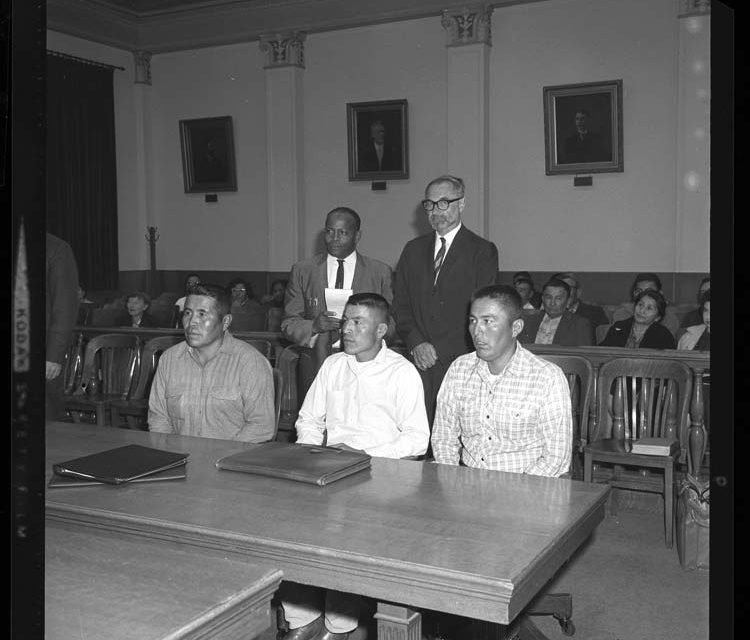
50 Years Ago: Major victory for use of peyote

Three Navajos face court at San Bernardino on charge of state narcotics law violation in use of peyote. They are, from left, Jack Woody, 29; Dan Dee Nez, 25; and Leon B. Anderson, 44. Behind them are lawyers, A. L. Wirin of Civil Liberties Union and Rufus Johnson. (Photo from UCLA Charles E. Young Research Library Department of Special Collections.)
ABOVE: Three Navajos face court at San Bernardino on charge of state narcotics law violation in use of peyote in 1962. They are, from left, Jack Woody, 29; Dan Dee Nez, 25; and Leon B. Anderson, 44. Behind them are lawyers, A. L. Wirin of Civil Liberties Union and Rufus Johnson. (Photo from UCLA Charles E. Young Research Library Department of Special Collections.)
WINDOW ROCK
A half century ago this month, the first major victory in the fight by Navajos to use peyote occurred in California.
The California Supreme Court, in a 6-1 decision, ruled that American Indians using peyote in their religious rites are not in violation of the state’s narcotic laws.
This landmark decision, said the Navajo Times, means the First Amendment, which guarantees freedom of religion, protects the use of peyote in ‘honest religious rites.”
This decision reversed the convictions two years ago of Jack Woody, 31, Dan Dee Nez, 25 and Leon B. Anderson, 44.
Their arrest occurred on April 28, 1962, when they were in a hogan in Needles, Calif., as part of a religious ceremony, which included the use of peyote. They were arrested after police officers observed part of ceremony and were later convicted of violating section 11500 of the state’s Health and Safety Code.
When police entered the hogan, according to court records, one of the Indians ‘handed the officers a gold-colored portrait frame containing a photo static copy of the articles of incorporation of the Native American Church of California, which stated: ‘That we as a people place explicit faith and hope and belief in the Almighty God and declare full, competent, and everlasting faith in our Church things which and by which we worship God. That we further pledge ourselves to work for unity with the sacramental use of peyote and its religious use.”
This had no effect on the police who continued with their plans to make arrests.
Interestingly, the court issued a decision in a companion case involving a group of non-Indians who were arrested a month after Woody in Palm Springs.
Charles Grady, who referred to himself as a ‘peyote preacher ” and a ‘way shower,” claimed that his self-proclaimed religion advocated ‘deep breathing ” as well as the use of peyote as a guide toward Christian life.
He and five of his followers were also arrested and convicted and the California Supreme Court ordered a new trial for the group in which they had to prove that their belief ‘is an honest and bona fide one ” rather than just an excuse to use peyote.
In their new trial, the judge ruled against them again and their convictions were upheld.
This case really did not address the use of peyote by Arizona and New Mexico Navajos in their homes states but it did pave the way for similar decisions in the future in both states.
Peter MacDonald and the Navajo Tribe paid for a rare front-page ad in the Navajo Times asking for the help of the Navajo people to track down the culprits of a horrendous crime that occurred during the recent Navajo Tribal Fair.
“$500 reward for information leading to the person or persons who stabbed six of the most valuable show horses during the 18th annual Navajo Tribal fair. Information should be directed to Peter MacDonald,” the ad stated.
Both the tribal police and tribal rangers as well as the Bureau of Indian Affairs law enforcement investigated the crime, coming up with no leads or even an understanding as to why someone would commit such a horrific crime.
In other news, reported this week by the Navajo Times, it seems that the people in Crystal Chapter are getting fed up with promises by the tribal government that one day the road to their community will be paved.
The BIA in August put out a notice that their plans are to start designing a new road to the community in 1968 — four years away. When it will actually be built, however, is anyone’s guess.
John Brown, who represents the community in the Navajo Tribal Council, said he and other members of the community are getting tired of traveling over muddy dirt roads to get to the community.
“I feel as the people do that we should have a road on the New Mexico side rather than the Arizona side,” he said in a front-page article.
With an all-weather road, the tribe will be able to open up the area to tourists who are looking for a good outdoor recreation place, he said, pointing out that the community is located at the foot of a mountain and has a lot of nice scenery.
U.S. Rep. Sam Steiger spoke that week to the Ganado Lion’s Club giving some good and some bad statistics about Indian Country.
“Today, there are about 380,000 Indians and 22,000 federal employees of the Bureau of Indian Affairs — about one federal employee for every 18 Indians,” he said. ‘Yet, the reservation Indian’s average life span is only 45 years, his illiteracy rate is the highest in the country and his housing is inadequate.”








 Highway 264,
Highway 264, I-40, WB @ Winslow
I-40, WB @ Winslow